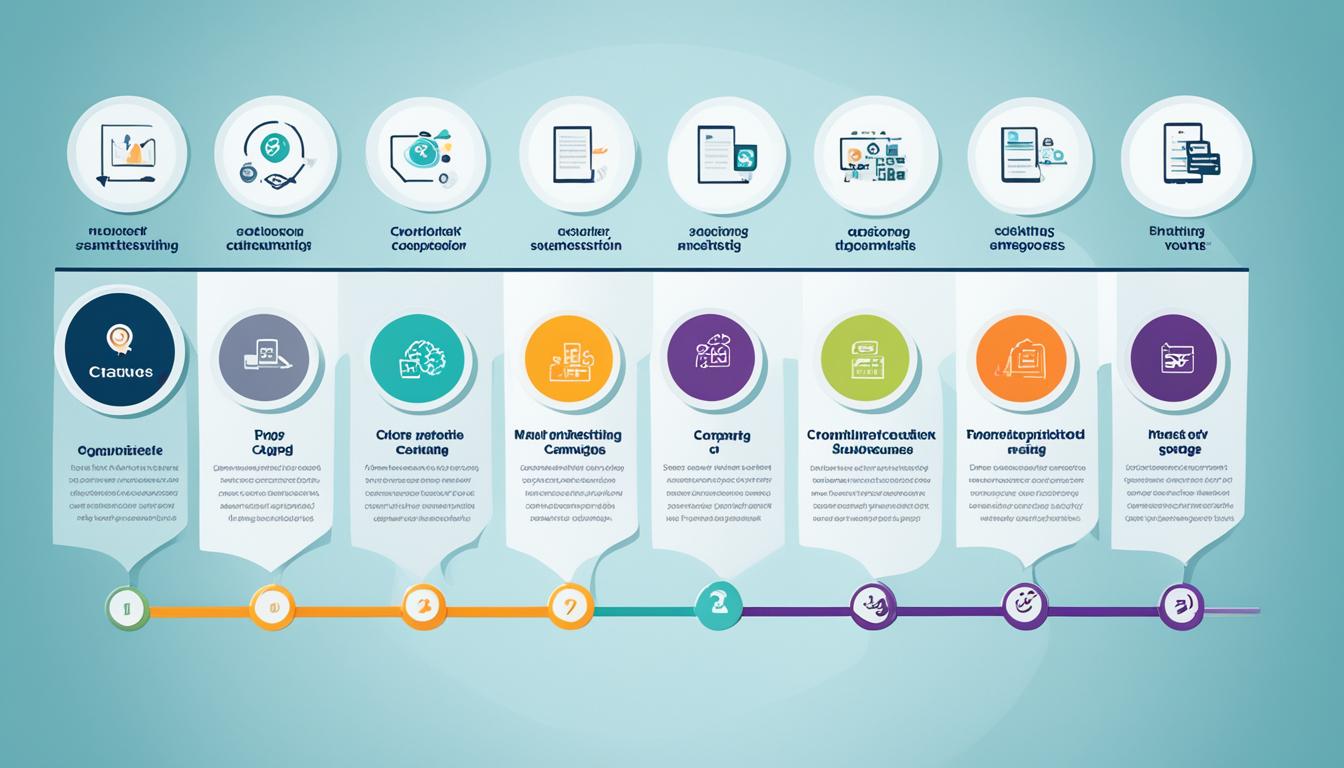In marketing, standing out is key. Using white space, or negative space, is an effective way to do this. It refers to the blank areas in design and branding materials.
Using white space might seem odd at first, but it’s really powerful. It makes things easier to read, brings attention to important info, and keeps everything looking balanced. So, white space isn’t just empty space. It’s a crucial part of making your brand look better.
This article talks about why white space is important in branding and ads. We’ll look at how to use it right in your marketing strategies. Plus, we’ll show examples of white space used well across different sectors.
Key Takeaways:
- White space in marketing refers to empty or unoccupied areas in design and branding.
- Incorporating white space strategically enhances readability and visual balance.
- White space highlights key information and creates a powerful brand impression.
- Using white space effectively can set your marketing materials apart from competitors.
- Successful examples of white space implementation can be found in various industries.
Understanding White Space in Business
White space in business is a goldmine for companies to innovate and grow. It lets them spot new opportunities and meet customer needs. By tapping into these areas, businesses can turn the unknown into valuable prospects.
Think of white space like an empty canvas. It waits for ideas, products, and services to cater to unmet market needs. Spotting these opportunities helps companies grow and fill market gaps.
White space analysis reveals the market’s landscape and its hidden potential. It involves studying customer needs and trends. This way, companies discover areas ripe for innovation and business growth.
Understanding white space lets companies create new products and services. This meets customer demands and reaches new markets. It’s a strategy to grow and stand out from the competition.
By tapping into the market’s white space, companies can gain an edge. They can spot unfulfilled needs and act on them. This can drive growth and turn untapped opportunities into success.
This image captures the essence of white space in business. It shows the growth and innovation that come from exploring these areas. Filling in the gaps can lead to hidden opportunities and elevate a company’s growth.
Benefits of White Space Analysis
White space analysis offers key benefits that can greatly help a business grow. It looks into the unseen gaps and opportunities in an industry. This helps companies find new ways to grow and innovate. Let’s look at the main advantages of using white space analysis in your strategy.
1. Increased Opportunities for Upselling and Cross-Selling
White space analysis helps businesses see unused potential in their current customers. By knowing what customers want, companies can offer more of what they like. This makes customers happy and increases sales. Such personal touches also make customer relationships stronger.
2. Expansion of the Customer Base
One top benefit of white space analysis is finding new people to sell to. By looking at new markets, businesses can draw in more customers. This not only brings more money but also makes the customer group more varied. It helps the business stay strong over time.
3. Uncovering Opportunities for Innovation
White space analysis leads to new ideas by revealing what customers are missing. Businesses can create new products or services to fill these gaps. This makes the company stand out and keeps customers coming back for more.
4. Improving Customer Relations and Retention
Doing white space analysis shows that a company really gets what their customers need. This makes customers feel valued and strengthens their bond with the company. Keeping customers is cheaper than finding new ones. So, this is a big win for any business.
5. Refining the Sales Approach and Strategy
White space analysis gives clues on how to sell better. It shows what different customers like. This lets businesses make their selling more effective. The sales team can meet customer needs better, leading to more sales and happier customers.
White space analysis brings many benefits that help businesses grow, satisfy customers, and sell better. By using these advantages, companies can find new chances, understand their customers more, and bring new ideas to their industry.
Leveraging Existing Customer Base
Starting with your existing customers is key when analyzing white space. They provide valuable data and opportunities for more sales. Upselling means offering extra products or better versions to improve their experience. Cross-selling lets you suggest products or services that meet different needs.
Targeted upselling and cross-selling to your current customers is cost-effective. They tend to buy again and spend more. By using the customer data you already have, you can find products or services they’ll like. This increases your chance of making more sales.
Focusing on current customers boosts the sales process and makes customer bonds stronger. It also keeps customers coming back. By understanding what your customers need and giving personalized suggestions, you create loyalty. This leads to lasting customer happiness and business growth.
Expanding Customer Base
White space analysis helps find new market chances and meets unmet needs. It’s great for growing the customer base and reaching different audiences. Through this, businesses can explore new opportunities, growing their market and income.
One major benefit of white space analysis is discovering untapped potential in various audience groups. By knowing the unique needs and preferences of these groups, companies can target specific demographics or areas. This approach helps them connect with a broader audience and enter new markets.
Using white space analysis to grow the customer base can open new market opportunities. It lets companies meet potential customers with different needs or preferences. This kind of expansion is key for business growth and a bigger market share.
Finding new customer acquisition chances through white space analysis is essential for businesses wanting a larger market reach. By spotting market gaps and unmet needs, companies can attract and engage new customers. This may include targeted marketing, creating new products or services, or moving into new areas.
| New Customer Opportunities | Targeting Different Audiences | Market Expansion |
|---|---|---|
| Identify and engage with potential customers | Understand diverse needs and preferences | Tap into new geographical regions |
| Create targeted marketing campaigns | Develop tailored products or services | Expand customer base and increase revenue |
| Establish relationships with new customers | Connect with previously untapped demographics | Drive business growth and market share |
Innovating with White Space
White space analysis helps find chances for innovation that meet uncovered needs. It looks at competition and what customers want. This way, businesses find ripe areas for new solutions.
White space lets companies add new features or products that the market lacks. It helps businesses stand out and be different from their competitors.
Talking to customers is key for making smart product development choices. Listening to their needs helps align innovations with what customers want. This ensures new products are welcomed in the market.
Competitive Analysis
For white space innovation, knowing your competitors well is crucial. You need to understand their offers and how they meet customer needs. This shows where you can be different and add more value.
This involves looking at product details, pricing, and how competitors handle customer experience and marketing. Spotting their gaps and weaknesses lets your business position itself better. This way, you can meet customer needs more closely.
Customer Preferences
Knowing what customers like is key in white space innovation. Market research and feedback tell what customers value and dislike. They also show desired features or services.
By matching innovations with what customers want, companies can make sure their new products hit the mark. This approach boosts success and customer uptake of new offerings.
Examples of White Space Opportunities
| Industry | White Space Opportunity |
|---|---|
| Automotive | Developing affordable electric vehicles with a longer range |
| Food & Beverage | Creating healthier and convenient meal options for busy professionals |
| Fitness | Introducing a personalized virtual training platform for home workouts |
| Technology | Designing user-friendly smart home devices with seamless integration |
The table above shows examples of where innovation can meet unmet needs across industries. These are areas where new ideas can have a big effect.
Leveraging white space helps businesses grow, gain market share, and stay ahead. By offering innovative solutions, they exceed customer expectations.
Refining Sales Approach and Strategy
White space analysis is key in improving the sales approach and strategy. It helps focus on different customer needs and preferences. By recognizing what each customer journey needs, like consultative selling or a soft sell, businesses can better their sales methods. This boosts sales effectiveness significantly.
White space analysis offers vital insights for sales managers to tweak product positioning and learn about competitors. Discovering what customers lack helps businesses decide and change their sales strategy as needed.
Making data-driven changes is crucial for meeting customer needs well. It involves knowing the customer journey, adjusting the sales process, and giving needed support. Aligning the sales approach with the customer journey enhances sales effectiveness and lifts return on investment.
Benefits of Refining Sales Approach and Strategy:
- Improved understanding of customer needs and preferences
- Enhanced product positioning and differentiation
- Increased sales effectiveness
- Greater customer satisfaction and loyalty
- Informed decisions based on market insights
Using insights from white space analysis lets businesses fine-tune their sales methods. Whether through consultative selling, a soft sell, or customized techniques, companies can increase sales efficiency for long-term success.
| Sales Approach Techniques | Description |
|---|---|
| Consultative Selling | Engaging customers in a collaborative and problem-solving approach to identify suitable solutions. |
| Soft Sell | Emphasizing relationship-building, persuasive communication, and indirect sales techniques. |
| Informed Decision-Making | Providing customers with comprehensive information and resources to empower their purchase decisions. |
Steps of White Space Analysis
White space analysis includes steps to find growth chances and meet customer needs. By following these steps, businesses can make choices based on data. This helps in driving growth and achieving success.
1. Customer Data Analysis
The first step is to know the current customers and analyze their data. This looks into key metrics, behavior, and what they buy. By understanding customer data, businesses can see where to invest and grow.
2. Account Segmentation
It’s important to divide customer accounts by their potential and structure. This step finds buying centers in companies and spots chances for more revenue. By doing this well, businesses can target the best opportunities.
3. Mapping White Space
To map white space, businesses identify market strengths and gaps. This can be internal by looking at what they already offer. Or external, by checking out competitors. Or by thinking ahead about market trends. Mapping white space helps find new areas for innovation.
4. Leveraging the Analysis
The last step is using what you learned to act. This may mean reaching out to new customers, targeting specific groups with marketing, or making new products. Acting on the analysis helps businesses use the opportunities for growth.
Putting White Space Analysis into Action
After identifying white space opportunities, companies must act to fill these gaps. This step is key for success. By using white space analysis, businesses can explore new territories and satisfy customer needs.
First, companies should reach out to potential customers found in the analysis. Personal interaction helps understand their needs and preferences. This way, companies can offer tailored solutions that truly resonate with customers.
Next, businesses should target specific audience segments with customized marketing materials. White space analysis offers insights into what different customers want. Creating relevant content makes it more likely that these customers will be interested in the products or services offered.
Another key strategy is developing new products or services. These should address the needs and challenges found in the analysis. Using customer feedback and market trends enriches product design. This makes the offerings more appealing and valuable to customers.
Using white space analysis effectively can lead to growth and a competitive edge. It involves direct communication with customers, targeted marketing, and strategic product design. Together, these efforts go beyond meeting customer expectations, setting businesses up for success in today’s market.
Tips for Effective White Space Analysis
Listening to your customers is key in white space analysis. It lets you find growth opportunities and areas for improvement. Customer thoughts provide insights, helping you see how your products can get better.
Update your products based on what customers say and market trends. This keeps you in the game. By changing your offerings to fit customer needs, you stay relevant in a fast-moving world.
It’s smart to look at new audiences as things change. As people’s likes shift, rethinking who your customers are helps tap into new markets.
Knowing what makes you better than competitors is also crucial. It lets you stand out in your industry. Find what sets you apart to draw customers seeking what you offer.
The Importance of Effective White Space Analysis
| Benefits of Effective White Space Analysis | |
|---|---|
| Identifying growth opportunities | ✓ |
| Improving offerings based on customer feedback | ✓ |
| Staying competitive in the market | ✓ |
| Expanding customer base and reaching new audiences | ✓ |
| Evaluating competitive advantage and differentiating yourself | ✓ |
Using these tips, you’ll gain insights and improve your products. Take in customer feedback and watch trends to succeed. Adapting quickly to changes keeps your business growing.
Conclusion
White space analysis is a key method for businesses to find new chances and satisfy customer needs. It helps companies grow, innovate, and connect with their customers more deeply. This tool uncovers areas where companies can be unique.
By analyzing, businesses spot opportunities that match what their customers want. This lets them make products or services that solve these needs, leading to growth and success. Staying on top of these opportunities helps businesses outdo their rivals and become market leaders.
Also, white space analysis boosts how well sales strategies work. It helps companies understand what their customers lack and plan their sales better. This leads to happier customers and more sales. Companies can also fine-tune their strategies to better fit the changing market, securing their future success.
In summary, white space analysis is crucial for businesses wanting to explore new opportunities, address customer needs, innovate, and sell better. Using this tool helps companies maintain their competitive edge, providing great value to their customers.




